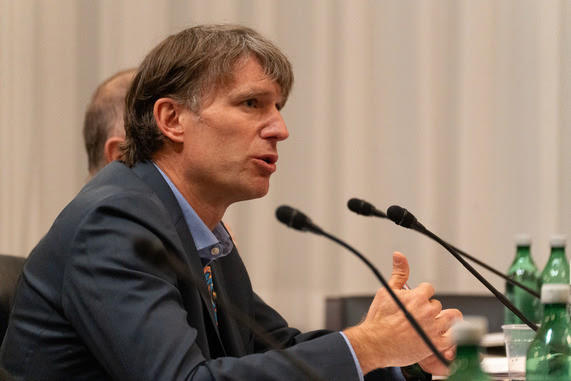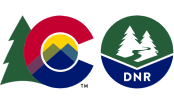
Washington, DC – Colorado Department of Natural Resources Executive Director Dan Gibbs, appeared in front of the House Committee on Natural Resources Subcommittee on Federal Lands to give testimony for an oversight hearing on public lands.
Executive Director Gibbs’ testimony focused on the importance of public lands to himself personally, living in rural mountain communities and his experience as a wildland firefighter to how Coloradans cherish public lands while also generating tremendous economic opportunities.
“We are privileged to live in a state that contains 22 million acres of public lands. We are truly blessed with a diverse array of natural resources and so we must be faithful stewards of the land so that all future generations have the same access and opportunities," said Director Gibbs, “The only way we can accomplish these goals is by working together to find the balance between resource extraction and conservation.”
A critical way Colorado interacts with the federal government is through Shared Stewardship agreements, which are formal agreements to work collaboratively on landscape-scale natural resources and outdoor recreation issues that often don’t abide by political boundaries.
“We are very proud of our Shared Stewardship agreement with the USFS, and we hope to soon finalize a similar agreement with the BLM” said Gibbs. “The Shared Stewardship agreements that were initiated under the first Trump Administration provide the structure to combine funding toward doing the right work, in the right place, at the right scale based on collaborative input to manage our forests and outdoor recreation.”
In his comments Director Gibbs also touched on the impacts of the current funding freeze on public lands and other conservation and recreation projects in the state.
“Funding that Colorado receives from the Federal Government is imperative to accomplish projects that cover everything from flood mitigation to dam and mine safety – typically in rural communities. Recent efforts to freeze federal funds are creating significant uncertainty, and concern among our constituents and are already negatively impacting these types of projects. Federal funding is the bedrock of these programs, and I encourage you to continue to partner with states,” said Gibbs.
A recording of the U.S. House Committee meeting is available here.
Dan’s oral testimony is released below in full:
House Natural Resource Committee - Subcommittee on Federal Lands: Restoring Multiple Use to Revitalize America’s Public Lands and Rural Communities
Hearing date: February 11, 2025
Witness: Dan Gibbs, Executive Director of the Colorado Department of Natural Resources
Testimony Statement
Introduction
Thank you, Chairman Tiffany, Ranking Member Neguse, and esteemed members of the Subcommittee. I’m excited to be here today.
Overview
As the Executive Director of the Colorado Department of Natural Resources, I’m proud to share the incredible work we do to meet our mission to develop, preserve, and enhance Colorado’s natural resources. I’ve led Colorado’s DNR since 2019, but my love for natural resources began while living in Gunnison County Colorado with the Gunnison River and public lands in my backyard. My parents were both public school educators and their experience as teachers influenced me to pursue a career in public service. Over my career, I have worked for Congressman Mark Udall, was a Colorado state representative and senator, and a county commissioner. I have also fought fires throughout the west as a certified wildland firefighter. I live in Summit County, which is a community comprised of over 80% federal lands.
We cherish public lands in Colorado. They provide a vital public good that improves the mental health and physical well-being of our residents and visitors while also generating tremendous economic opportunities. Colorado is an all of the above energy state, and we work hard to balance the energy transition with the need for reliable energy. For instance, Colorado is the fourth-largest oil-producing state; with vast natural gas reserves, coal, hard rock minerals, geothermal sources, and seemingly limitless sunshine and consistent winds that assist our efforts to increase renewable energy generation.
Outdoor Recreation Economy
In addition to enabling resource extraction, our public lands support a growing outdoor recreation economy. We are privileged to live in a state that contains 22 million acres of public lands. Colorado’s expansive prairies, mountain river valleys, and desert canyons are central to our lifestyle, heritage, and identity.
Colorado’s outdoor recreation industry contributes $36.5 billion in GDP and represents 12% of the state’s entire labor force. To manage this, we have developed robust partnerships between local, state, federal, and tribal entities through Colorado's Outdoor Strategy and the Regional Partnerships Initiative. Through this proactive approach, Colorado’s dedicated staff works closely with federal partners to responsibly manage and enhance outdoor recreation.
In Colorado, we proudly work hand in hand with our federal partners, as evidenced by our successful co-management of the Arkansas Headwaters Recreation Area since 1989. The BLM and US Forest Service own much of the area along 152 miles of the Arkansas River, and Colorado Parks and Wildlife collects user fees to help pay for the management of boat launches, campgrounds, and river rescue. This co-management effort has been so successful that we are exploring replicating that model in the Pikes Peak Region in Colorado Springs.
Shared Stewardship
As a wildland firefighter and resident of a fire-prone community, I have seen first-hand the risk that megafires pose. Because wildfires don’t distinguish between federal, state, private and tribal lands, we need a management strategy that reflects an all-lands approach.
We are very proud of our Shared Stewardship agreement with the USFS, and we hope to soon finalize a similar agreement with the BLM. The Shared Stewardship agreements that were initiated under the first Trump Administration provide the structure to combine funding toward doing the right work, in the right place, at the right scale based on collaborative input to manage our forests.
Colorado and much of the arid west is just one lighting strike or one unattended campfire away from the next devastating megafire. By prioritizing, planning, and working together, we can take advantage of shared federal-state resources to create the economies of scale needed to treat the right acres to protect lives, property, and critical infrastructure.
Shared Stewardship should not be limited solely to forest management. Instead, we should apply this important tool broadly to collaboratively manage trails, water resources, wildlife, and much more.
Rural Communities, Public Lands, and the Role of the Federal Government
As a former Summit County Commissioner, I know our rural communities and understand the challenges they face. We must manage and fund public lands in a way that allows for these communities to also reap the benefits. In Colorado, our extensive network of stakeholder working groups collaborate to get boots on the ground to complete critical conservation projects in an efficient and cost-effective manner.
The funding that Colorado receives from the Federal Government is imperative to accomplish projects that cover everything from flood mitigation to dam and mine safety – typically in rural communities. Recent efforts to freeze federal funds are creating significant uncertainty, and concern among our constituents and are already negatively impacting these types of projects. Federal funding is the bedrock of these programs, and I encourage you to continue to partner with states. Together, we can leverage our natural resource funds to obtain extraordinarily efficient, cost effective, and lifesaving outcomes.
Conclusion
Thank you for giving me the opportunity to speak about Colorado’s collaborative approach to managing our natural resources. In the West, we are truly blessed with a diverse array of natural resources and so we must be faithful stewards of the land so that all future generations have the same access and opportunities. The only way we can accomplish these goals is by working together to find the balance between resource extraction and conservation.
